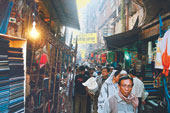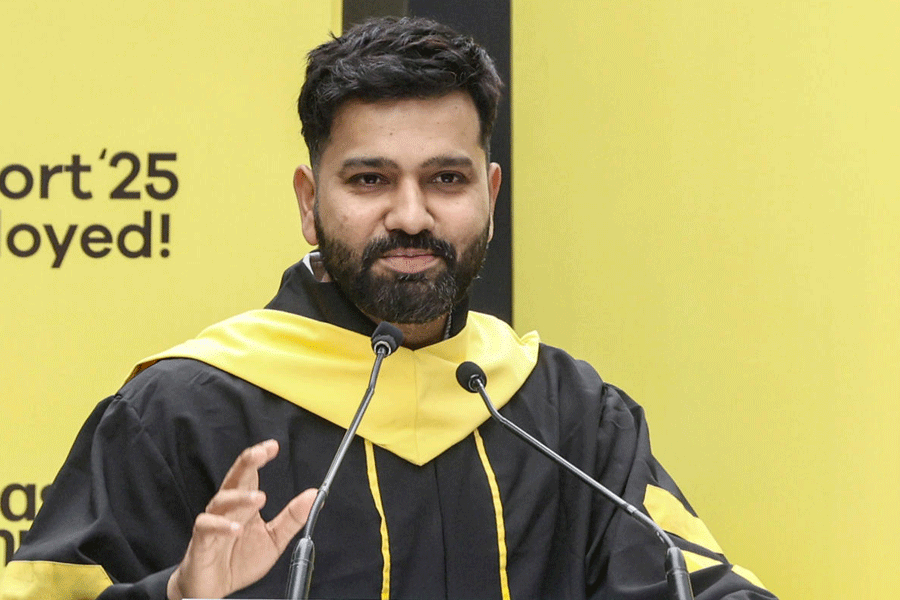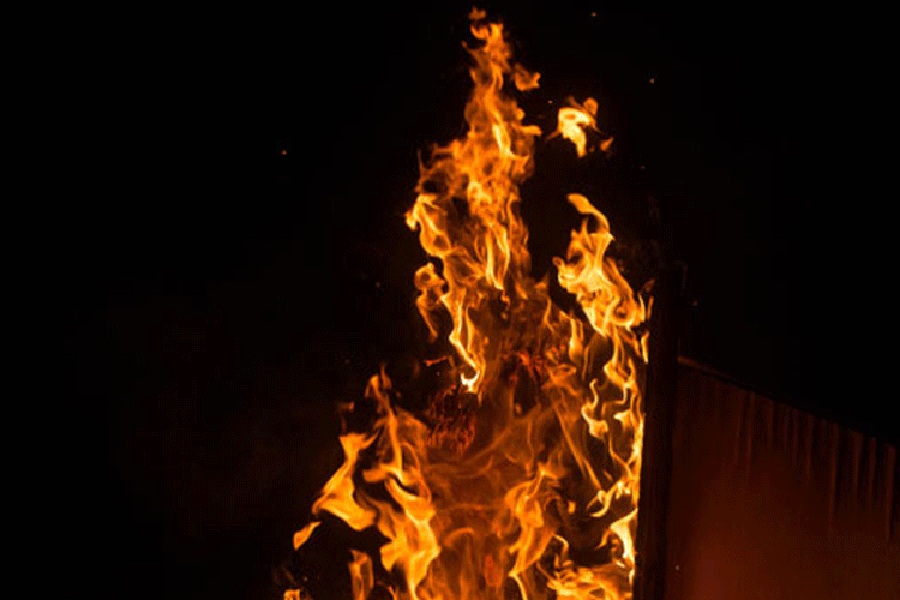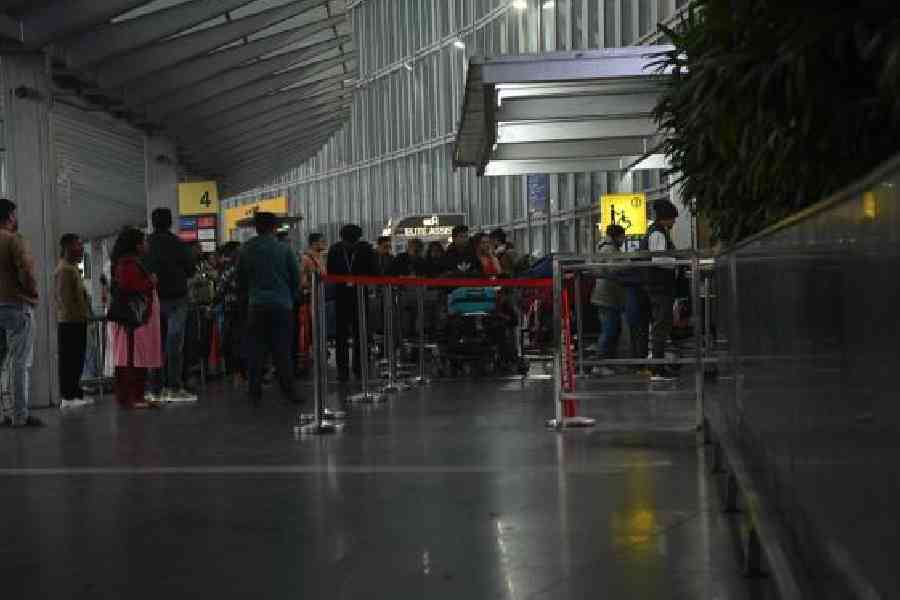 |
 |
 |
 |
| (From top): A bustling street in old Dhaka; a Bangladeshi rickshaw-puller; a view of the city’s medical college, the sculpture of the Mukti Bahini revolutionaries in front of Dhaka University |
Every time I visit Dhaka, I think of Princess Jahanara entering Shahjehan’s court in sheer muslin that had passed through a finger-ring and being told that she should come to the Diwan-e-khas more appropriately dressed! Once I hit the heart of the city, I check around with friends about the fabled Dhaka muslin. But the looms, alas, for such fine craftsmanship have stopped humming centuries ago. Just a handful of villages in and around Dhaka still spin out the famous Dhakai saris. The rest of the city has got hooked to nylons and Rolex-bordered saris and dupattas that reflect the worst of Bollywood.
If change is inevitable, Dhaka is one city that seems trapped in its tentacles. It stands in a state of bewilderment, caught in a time warp, unsure as to whether it needs to bravely march forward or remain ensnared in its strange, medieval incarceration.
Across the war-ravaged visage of Bangladesh there is, perhaps, still an element of tenderness that no military r?gime has been able to wipe out. And this is reflected in the lanes and by-lanes of the country’s capital, which is an amalgam of beauty and wretchedness in equal measure. From the airport itself ? a crazy confusion of hordes of passengers ready to fly to different destinations, and the multitude of friends and relatives who come to see them off ? you become aware of a country still trying to find its identity. The drive into town exposes you both to swanky skyscrapers and miserable roadside shanties.
And once you hit the mainstay of Dhaka, you also confront the city’s inevitable schizophrenia. Everything seems larger than life and fragmented. American-style food courts rub shoulders with local eating houses. Modern shopping malls give way to bustling Oriental bazaars. With every Mercedes driving past, there are a hundred dilapidated Japanese jalopies jamming up the streets. A tangle of mosques, houses, filigreed balconies and some stunning row-houses leap into your vision in a kaleidoscopic mirage.
On an assignment to shoot a film, I am taken around to see the ideal spots for outdoor locations on a recce that gives me my first exposure to such a fascinating city ? a city that has been historically fabled for its wealth since the days of the Mughal Empire. From Akbar to Aurangzeb, Delhi monarchs looked upon Dhaka as a veritable treasure trove and some of the best generals were sent time and again to book disloyal local rulers. Today, ironically, the divide between the rich and the poor is hard-hitting and visible. In the posher areas of Gulshan and Bonani you could well be fancying yourself driving through London suburbia. Wide roads are flanked by flowering gulmohars and jacaranda that shelter designer homes complete with parking space for half a dozen imported cars and private swimming pools. You could dine at some of the best eateries, shop at some of the best boutiques and meet the rich and the genteel garbed in French couture and glittering diamonds. And then, ironically, the minute your vehicle hits the first pothole, you could, a la Cinderella, almost find your car turned into a pumpkin about to ram into a row of rickshaws!
Suddenly, all around you is a confusion of traffic and ordinary people, rushing around to complete their daily chores. This is the amorphous middle-class of the city. For every young man who has wriggled into his crotch-hugging Wranglers and every young woman sporting her denims, there are multitudes of men and women in traditional garments ? men wrapped in lungis and with prayer caps covering their skulls, and matrons at food and vegetable stalls in the open market hidden behind diaphanous burkhas. Perchance, as you stroll through the bazaars, you may glimpse a pair of mysterious, kohl-rimmed eyes staring at you through the netted windows of the veil. In the daily grind, there are remnants of a past that must have been glorious. In the heart of the city is the Company Bag or the municipal gardens that shelter flowers and birds and trees and lovers in profusion.
On Bengali New Years’ day, entire arbours turn into venues of great festivity. In the West Maligag area, even though the streets are crowded with cycle rickshaws, I am amazed by their colourful hoods and the zest with which they are manoeuvred through the traffic. Through a stretch of mundane cityscape you could suddenly glimpse upon the unique architecture of a mosque, covered in intricate arabesque and with soaring minarets reaching for the azure sky. You could, at a pinch, even take a detour and visit Sonar Gaon, about an hour and a half away, now declared a World Heritage City.
There is the aroma of kebabs being fried in the tiny thoroughfares of Dhan Mandi and the older parts of the city sport open food stalls where you could sit with the multitudes and dig into a plateful of steaming rice and a pungent curry of the famous Padma hilsa doused in mustard sauce. When in Dhaka, you cannot come away not having eaten Mama’s halim or shopped for local handicraft and the renowned Dhakai sari at the various outlets of Arong. It is through this chain that the city’s most famous designer, Bibi Russell, sells her much-in-demand couture. Whether you are having a drink at the snobbish Dhaka club, dining at Sanjeev Kapoor’s much-hyped Khazanaor or eating on the streets, Dhaka is a panacea for non-vegetarian aficionados.
The University area, with its spick and span buildings and wide boulevards, is still considered the city’s intellectual hub. The circular road divides, known as chattars, are often christened after the country’s flora and fauna. The famed Medical College carries oodles of nostalgia for those who had studied there before the Partition. Here began the fabled students’ movement that spearheaded the fight for the mother tongue and here are sculptures strewn all over the campus commemorating the martyrs of the Mukti Bahini who fought for the independence of the country in 1971.
In Savar, on the outskirts of the city, there lies an entire arcadia dedicated to the memory of the freedom fighters. Mujibur Rehman is still considered a hero and in Dhaka the essence of Bengali culture is fiercely preserved. Whether it is in the area of fine arts or music, the cognoscenti are very particular about their creative tastes. Art house film directors, exponents of Tagore’s music, painters and sculptors take their task seriously, never mind the tightening claws of the conservative clergy.
For a generation of Bengalis, Dhaka wears its own peculiar muslin embroidered in delicate stitches of nostalgia and as I come away, the city, like Ritwik Ghatak’s protagonist, Nita, in Meghey Dhaka Tara opens wide its deep cozening eyes and pleads, ‘Dada, ami banchtey chaai (‘Brother, I want to live’)!
Photographs of the sculpture and the Parliament house by the author










